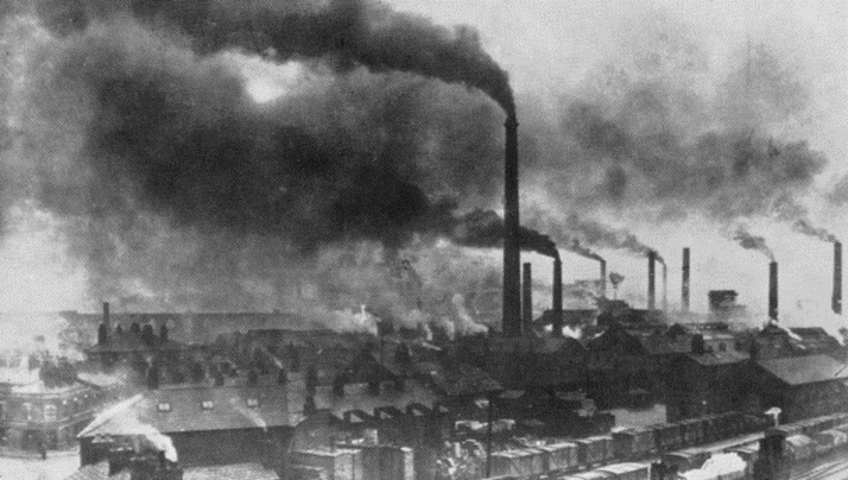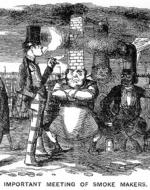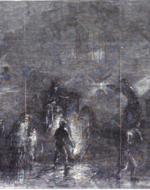Created by Kiley Hunziker on Sun, 03/31/2024 - 14:46
Description:
Introduction
Charles Dickens’s Hard Times showcases the negative effects of industrial towns. He uses strong imagery to depict the smoke-filled factories that he describes as “a blur of smoot and smoke” (Book 2, Chapter 1). The fog of these factories was constantly overhanging the characters as they went through their daily lives. The owners and richer characters, like Mr. Bounderby, wears the smoke like a trophy, while the Hands see it as a constant in their life. The narrator of the story, who describes many of these images, acts as an almost outside perspective of the town. He relates how air pollution is more than just a tool to measure the amount of productivity is going to Coketown and factories but has more realistic consequences.
Stephen Mosley, in his article “Selling the Smokeless City” describes the different views of smoke production. The rich, the ones who benefit from these factories, try to romanticize, and make these cities an aesthetic. The smoke became “commonly understood as an unmistakable sign that Britain’s industrial towns and cities were flourishing” (Mosley 2). Even the workers say this as a “’normal’ part of daily life” and meant “bright trading creations, jobs and wealth” (Mosley 2). Mosley, as the narrator does in Hard Times, provides a larger point of view of the consequences of industrialization and this air pollution. There was a “loss of sunlight; destruction of vegetation; blackened buildings; and not least of all damage to people's health” with the conclusion that “smoke was preventable, uneconomic, and a waste of natural resources” (2). Mosley argues that air pollution from the factories tend to become romanticized to hide and overlook the negative consequences. How is air pollution twisted to look beneficial and positive? What is the reality of the situation?
The images in this gallery dive into the different views of the Industrial Revolution’s air pollution in 19th century Britain. Through photographs, paintings, and satirical drawings, the consequences of this issue shines through the fog of aestheticism that has surrounded this topic.
Images in the Series
Fig. 1. Birmingham: ‘an immense workshop, a huge forge, a vast shop’ (de Tocqueville). Victorian Web, victorianweb.org/places/cities/birmingham/prosser.html.
This photo depicts a factory town in Birmingham, England during the 1800s. It is an example of what workshop town would have looked like during the Industrial Revolution. The main focus of this image is the amount of smoke these buildings produce; it seems to blacken out the sky and the town. This constant emptying of smoke is personified by Dickens and describes a similar scene: “interminable serpents of smoke trailed themselves for ever and ever, and never got uncoiled” (Book 1, Chapter 5). These “serpents of smoke” tangle themselves around the town, slowly suffocating both the environment and the workers. There is a comparison here between Dickens’s description and the photographic evidence of these towns. Dickens is able to shape these pillars of smoke into a fantastical image. In reality, there is nothing fanciful about what is happening, especially when one imagines working in these types of conditions day in and day out.
Fig. 2. May, Margery. The Valley of Desolation. The English Illustrated Magazine, Victorian Web, victorianweb.org/periodicals/englishillustrated/5.html.
Margery May’s painting, named “The Valley of Desolation,” was featured in The English Illustrated Magazine. The article written with it describes the affect of pollution on rural areas. This painting emphasizes this fact. There is a comparison between the natural environment and the new landscape of the Industrial Revolution. Even though they are currently separate, these towns and factories seem to be looming over the rural landscape, already spreading its smoke and ash onto it. Charles Dickens describes the need to escape into these rural areas: “…it was customary for those who now and then thirsted for a draught of pure air, which is not absolutely the most wicked among the vanities of life, to get a few miles away…” (Book 3, Chapter 6). The narrator creates a sarcastic tone when the workers desire air free of contamination because fresh air means no productivity. It shows the encroachment of pollution on the natural environment, and how some things are worth more than productivity and money.
Fig. 3. Important Meeting of Smoke Makers. 1853, Punch 25. Victorian Web, victorianweb.org/science/environment/basdeo.html.
Punch, a satirical magazine, first published “Important Meeting of Smoke Makers” as a remark of the air quality during the 1800s. It is important to note that the “Smoke Makers” are represented by a number of different people in different socio-economic classes. There is both the rich and poor, the factory workers and the businessmen. Stephen Basado, PhD, used this photo in his research article, “Old King Coal.” Basado mentions that many of them held the same opinion about smoke and air pollution during this time: “…businessmen seem to have thought, as the saying goes, “where there’s muck there’s brass” (Basado, “Old King Coal”). The workers must have agreed, for “a smokeless chimney signified enforced idleness, hunger, and poverty” (Basado, "Old King Coal"). Mr. Bounderby supports these ideas when he says the smoke is “…meat and drink to use. It’s the healthiest thing in the world…particularly for the lungs” (Book 2, Chapter 2). There is carelessness here, with these group believing smoke equal money, while overlooking the other harmful consequences. “It is because smoke pollution began to increase so much during this period, leading to global environmental problems such as climate change…” (Basado, “Old King Coal”). With production clouding their vision, there were later, larger-scale consequences.
Fig. 4. A London Fog. 1849. Image courtesy of the Hathi Trust Digital Library and the University of Michigan Library. Victorian Web, victorianweb.org/victorian/science/environment/1.html.
This painting named “A London Smog” was first published in the London News in December of 1849. In this painting, another effect of pollution is shown: smog. When Dickens describes the “direful uniformity” of these towns, he meant more than just doing the same thing day in and day out. During these days when the smog presses down, as seen in the painting, the people blur into the same person, and it is hard to get a grasp on your surroundings. In the article “Selling the Smokeless City,” Stephen Mosley mentions that artists were drawing inspiration from the “unusual light effects of the polluted air” and “writers too often praised the urban smoke cloud for its aesthetic appeal.” This smog, though, has a more deadly and realistic side than its romanticization. Stephen Basado writes in “Old King Coal”: “In December 1873 a fog lasting three days killed over 700 people; in 1880 another fog disaster resulted in approximately 1000 excess deaths…” These were just a few occurrences of the number of deaths that were caused in light of the smoke.
Works Cited
Basdeo, Stephen. “Old King Coal.” Victorian Web, victorianweb.org/science/environment/basdeo.html.
Dickens, Charles. Hard Times. COVE Studio, BRADBURY & EVANS, 1854,
https://studio.covecollective.org/anthologies/eng-l302-anthology-sp24/documents/hard-times.
Mosley, Stephen. “Selling the Smokeless City: Advertising Images and Smoke Abatement in Urban-Industrial Britain, circa 1840–1960.” History & Technology, vol. 32, no. 2, June 2016, pp. 201–11. EBSCOhost, https://doi-org.proxy.ulib.uits.iu.edu/10.1080/07341512.2016.1218956.





